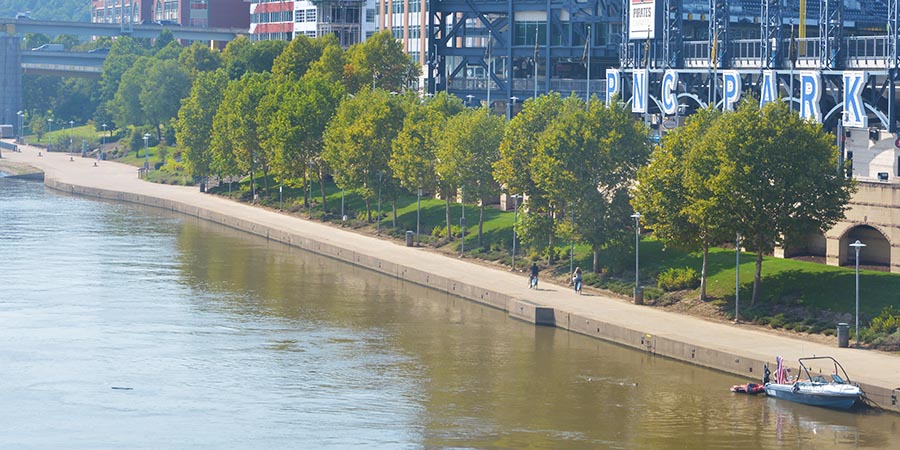Green Infrastructure solutions are both functional and attractive, and are coming into use more and more in Pittsburgh, PA and beyond. GAI Water staff describe how these innovative strategies work to manage stormwater—naturally.
Green Infrastructure Meets Pittsburgh Stormwater Challenges
Green Infrastructure solutions are providing an effective first line of defense for meeting the substantial stormwater management challenges of the Pittsburgh, PA area. Surrounded and crisscrossed by rivers and streams, peppered with former industrial sites, and prone to heavy rainfall, much of Pittsburgh and the surrounding region is serviced by aging stormwater-management infrastructure.
Slowing The Flow
The Pittsburgh area has an old combined sewer system that has to convey stormwater in addition to wastewater from homes and businesses. The system is not scaled to meet modern demands, and as little as 1/10 of an inch of rain can overload some systems with stormwater.

Much of the quick overload of Pittsburgh’s combined sewer is due to the city’s high prevalence of impervious surfaces like concrete, which swiftly channel stormwater into the over-taxed sewers. This is where Green Infrastructure comes in.
Green Infrastructure solutions help slow the flow of stormwater by offering permeable surfaces that allow water to move below ground level, and they often provide temporary on-site storage for stormwater rather than allowing water to flow freely to the sewers. Working as a complement to traditional “gray” infrastructure—sewer pipes, tunnels, etc.—Green Infrastructure acts to ease the burden on the combined sewer, help mitigate overflow, and provide initial stormwater infiltration and filtration of sediments and contaminants.
Beauty Above, Business Below
Green Infrastructure mimics natural processes that capture and slow stormwater. Many are marked by vegetation and other landscaping features that make them attractive to look at while they perform a valuable water-management function. A bioswale is a natural-looking Green Infrastructure solution that one might walk right by without even noticing.

“Bioswales are engineered trenches filled with layers of soil and rock and topped by grasses or native plants—they’re often used in parking lots, public spaces, or positioned to catch roof and sidewalk runoff in housing developments,” said GAI Assistant Engineering Manager Joe Fello. Bioswales have sloped sides that channel water downward—while the bioswale slows water flow, the plant roots and soil help filter out pollutants. “The gravel, sand, or stones at the bottom of the bioswale provide more filtration and temporary storage for the water, which can then slowly drain into the aquifer or be conveyed to local waterways through an installed drainage system,” said Fello.
Other Green Infrastructure solutions like rain gardens, permeable concrete and pavers, bioretention facilities, and more help reduce, slow, and filter stormwater, while solutions like green roofs—which top buildings with vegetation and other natural elements—have the added benefit of helping reduce power consumption by keeping rooftops cool.
Maintenance Challenges
While effective and pleasing to eye, Green Infrastructure’s relative newness may present challenges to owners who are not staffed or skilled to perform the maintenance necessary to ensure that the solutions function properly.
“Green Infrastructure is quite different from installing a pipe in the ground, which may need only minimal attention for the next several years,” said Fello. “There are landscaping considerations in many cases, and even small trash like candy wrappers can affect the functionality of Green Infrastructure—so site owners may need to assess and retool their maintenance programs to properly provide the service and attention that Green Infrastructure requires.”
Combined Expertise Creates Effective Green Infrastructure
Effective Green Infrastructure solutions represent the collaboration of a range of disciplines. “We have hydrogeologists, civil engineers, landscape architects, GIS mapping technicians, biologists, and others working together for the various projects large and small that we work on at GAI,” said Fello. “We draw on more than 500 local specialists, and each Green Infrastructure collaboration is focused on creating solutions that meet PA DEP requirements, yet are also cost effective and minimize maintenance for our clients while working to provide clean water and sustainable stormwater management well into the future.”
Contact Joe Fello, 412.399.5374, for more information about Green Infrastructure and the full range of GAI’s water-management infrastructure services.
![]() Joe Fello has been with GAI since 2010. He specializes in civil engineering for residential, commercial, industrial, and institutional land development projects. He is proficient in design of green stormwater infrastructure and post-construction stormwater management.
Joe Fello has been with GAI since 2010. He specializes in civil engineering for residential, commercial, industrial, and institutional land development projects. He is proficient in design of green stormwater infrastructure and post-construction stormwater management.


